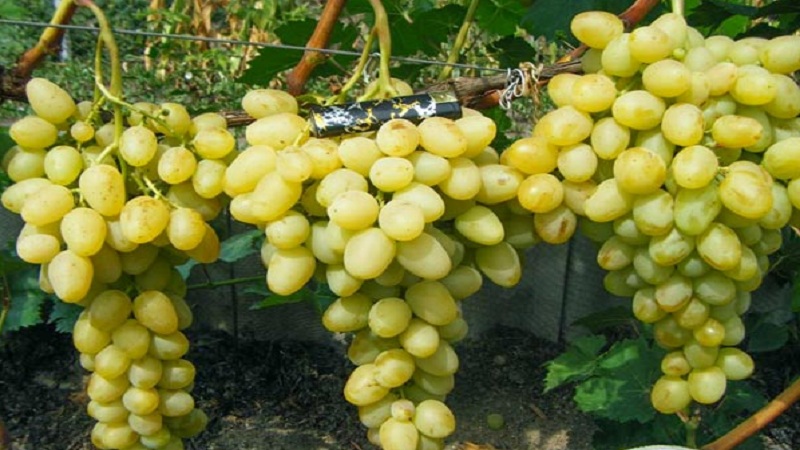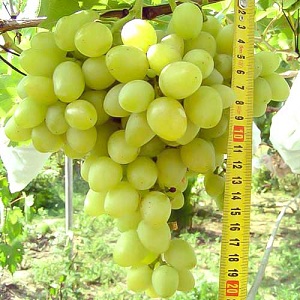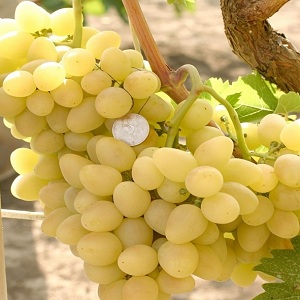Arcadia table grape review
The Arcadia table grape, formerly known as Nastya, has been popular with winegrowers for several decades. This is facilitated by a harmonious, balanced taste, high yield, frost resistance and unpretentious care. The variety is grown even in France, and the inhabitants of this country certainly know a lot about grapes.
The content of the article
Description and history of the origin of Arcadia grapes
Arcadia is a table variety obtained by crossing the dark-skinned table varieties Cardinal and Moldova. The selection work was carried out by the engineers of the VE Tairov Institute of Viticulture and Winemaking under the direction of E. N. Dokuchaeva.
The parental genes of these varieties were used to create other grape varieties, but it is Arcadia that is considered the best. There is also a second name - Nastya, but it did not take root.
The culture is distinguished by its early ripening period and high productivity. With good care, the bushes grow quickly and begin to bear fruit. The fruitfulness of the vine is 55-75%.
The variety is suitable for growing in regions of Russia with a temperate and warm climate, throughout Belarus, Ukraine and Kazakhstan.
In the photo - Arcadia grapes.

Variety characteristics
The Arcadia grape is endowed with the following characteristics:
- The ripening period of berries is 115-125 days from the moment the buds appear.
- The bushes are tall, the leaves are large, five-lobed, green in color with a white edge. About 70% of young shoots give fruit clusters.
- The flowers are bisexual, do not require pollination, and can pollinate other varieties.
- The average weight of a ripe bunch is 500-700 g, the maximum is 2 kg. The shape of the brush is conical. The bunches are medium or dense, often with branches.
- The berries are round, slightly elongated, heart-like, 2.3 cm in diameter, weighing 7-15 g.
- Coloring at the stage of technical ripeness is white or light yellow, biological - amber.
- The skin is thin, but dense, with a white waxy coating.
- The pulp is juicy, dense, fleshy.
- The taste is balanced, moderately sweet, nutmeg aroma. Sugar content - 16%, acid - 5-6 g / l.
- Resistance to fungal mildew disease is high - 3.5 points (double treatment is required).
- The culture is resistant to frost down to -23 ° C, it needs light shelter for the winter.
- The average yield is 18–20 kg per bush. In especially fruitful years, it is possible to get up to 50 kg from one bush.
- When planting by cuttings signal clusters appear after two years after landing... A full harvest is removed after three years. If the planting method was by grafting, the first crop is harvested in the second year.
In 2011, in the III International Competition-Exhibition “Golden Bunch of Grapes”, the Arcadia variety received the Grand Prix Cup and a gold medal as the best table variety.
Advantages and disadvantages
Advantages of Arcadia grapes:
- pleasant balanced taste and aroma;
- attractive appearance of the bunch;

- keeping quality;
- high level of transportability;
- early maturity;
- high productivity;
- flowers do not need additional pollination;
- frost resistance;
- cuttings root quickly;
- ease of care;
- resistance to mildew.
disadvantages:
- susceptibility to infection with powdery mildew and gray rot without preventive treatments;
- cracking of berries in conditions of high soil moisture.
Growing technology
Compliance with the rules of planting and caring for Arcadia grapes is a guarantee of health and high productivity of the culture.The plant prefers sunny areas, protected from gusty winds and drafts.
A part of the garden with tall trees and buildings nearby is not suitable for planting grapes. Shading negatively affects the growth and development of the bushes, the ripening period and taste of the berries.
Terms and rules of landing
There are no special requirements for the type of soil. It is important that the soil is moisture and breathable. Stagnant water leads to the death of the vine.
The variety is easily propagated by cuttings, which are characterized by survival rate in 90% of cases. They can be purchased at specialty stores and nurseries, or ask your neighbor.
When choosing seedlings, pay attention to the root system. It should be healthy, free from damage and signs of rot. Before planting, the roots are immersed in water for 24 hours.
Planting is performed in April. This guarantees the best survival rate and quick adaptation of the seedling in a new place. Daytime air temperature should be kept at + 15 ° С, soil - + 10 ° С.
The landing pit is prepared in advance. In the summer, the site is dug up and manure is brought under a shovel. In the fall, they dig a hole 70x70 cm. At the bottom they put crushed stone or broken brick with a layer of 15 cm. Pour earth mixed with humus, 5 kg of half a bucket of ash and 500 g of "Azofoski" on the top, then pour clean fertile soil so as not to burn the young roots. Then 10 liters of water are poured and wait for the soil to sag.
A wooden stake is driven in the center of the hole to garter young shoots. The cuttings are buried so that no more than two buds remain on the surface, the roots are carefully straightened, the hole is completely filled with soil and watered with clean water. The surface is mulched with peat, sawdust or hay.
Important! Experienced growers recommend leading a pipe to the bottom of the pit for sufficient moisture to the root system in the early years of development.
Trellis are used to tie the shoots and place them from north to south. The easiest way is to pull the wire between the dug-in supports. The distance between the supports is 3 m, between the rows of wire - 30 cm. The bottom row is placed at a height of 0.5 m from the surface.
You cannot do without support - the grapes are heavy, and it is difficult for the shoots to support their weight. In addition, on the support, the brushes are illuminated by the sun from all sides and are evenly colored as they ripen, and the leaves do not clump and are rarely affected by fungal infections.
Shoots are tied up in the second year of development on a wire parallel to the ground. The growing shoots are fixed on the next line after reaching 30 cm in length.
Interesting! The ancient Egyptians cultivated grapes on the banks of the Nile as early as 6 thousand BC. e.
Care features
Arcadia grapes require regular but moderate moisture. More intensive watering is provided before flowering, bud setting and berry formation. In the future, they are guided by the weather. At the end of July, watering is stopped - during this period, the berries are gaining sugar content.
At the end of autumn, the so-called water-charging irrigation is performed - the soil is watered abundantly with water so that the roots absorb the maximum amount of moisture. This will ensure a successful wintering for the grapes. Shoots are removed from the trellis, laid on the ground and covered with slate, agrofibre or plastic wrap, and covered with earth on top.
Top dressing scheme:
- Wood ash is mainly used as fertilizer: every year 2-3 liters for digging.
- Once every two years at the beginning of spring, 20 liters of compost are added for digging.
- In summer, grapes are sprayed 3-4 times with vitamin and mineral compounds: 10 g of boric acid per 10 liters of water or 100 g of ash, 10 g of potassium sulfate, 20 g of superphosphate. Spraying is performed in the evening or in cloudy weather to keep the foliage wet longer.
- Before and after flowering, the bushes are fed with a weak solution of complex minerals (4 g of sodium humate, 5 g of boric acid per 10 L of water), and after 2-3 weeks - only potassium and phosphorus (20 g of potassium sulfide, 40 g of superphosphate per 10 L of water ).
Pruning
Pruning bushes is an important agricultural technique. Main goals: rejuvenation of grapes, stimulation of the formation and growth of shoots to obtain a rich harvest.
Cut bushes in early spring when the buds are dormant. Remove dead or frozen shoots. In autumn, the shoots are shortened to two buds. They will form two sleeves.
In the summer, stepchildren are removed to stimulate the ripening of the bunches.
Autumn pruning is preferable for grapes grown in the middle lane. Wintering after pruning takes place with minimal losses, and the formed bushes are easier to cover.
Council. Always leave only strong and healthy shoots on bushes.
Possible problems, diseases, pests
The Arcadia variety has a low immunity to powdery mildew - powdery mildew.
The main signs of the disease:
- growth retardation of shoots;
- curly leaves covered with a grayish-white bloom;
- inflorescences and bunches as if sprinkled with flour or ash;
- dying off of inflorescences;
- cracking and drying of berries.
To combat the fungus, the vineyard is dusted with sulfur or preparations with colloidal sulfur are used. For processing after flowering, the preparations "Baylon", "Topsin M", "Rubigan" are allowed. The products stay on the leaves longer and are not washed off by rain.
To prevent the spread of oidium, the bushes are sprayed twice a season - in spring and autumn. To do this, use the drug "Ridomil" and a solution of Bordeaux liquid.
The causative agent of gray rot affects not only grapes, but also other crops, for example, strawberries. Spots appear on the affected leaves, the flowers darken and fall off, the shoots turn white and become covered with a gray bloom, the berries turn gray-brown.
For spraying bushes during the formation of inflorescences use the drug "Horus", during the flowering period - "Horus" and "Skor", during the ripening period of berries - "Switch" and "VDG".
The most dangerous pest of grapes is the grape roll. Caterpillars damage buds, flowers and berries, destroying up to 40% of the crop. A fungus develops on damaged berries, causing gray rot.
The most harmful are the third and fourth generations of the grape roll. The years of the third generation of butterflies begins in early August, before the berries ripen, the fourth generation - during the ripening of the crop. Caterpillars attack bunches of ripe grapes, so the use of chemicals is contraindicated.
To combat the pest, a new and improved drug "Engio 247" is used. Liquid consumption - 500-600 ml / ha. The protection period is 7-20 days. The frequency of spraying is two times.
The drug is recommended for the destruction of second and third generation leafworms. To destroy the caterpillars of the fourth generation, biological preparations "Fitoverm" (3 g per 10 l of water), "Lepidocid" (30 mln and 10 l), "Aktofit" (20 ml per 10 l), "Bitoxibacillin" (60-80 g 10 l).
To protect against attacks from wasps, the bunches are placed in fabric or mesh bags. The thin skin and sweet flesh attract insects.
Reproduction
The Arcadia variety is propagated by cuttings. Their preparation begins in the fall. Cuttings 30 cm long and 10 mm thick are cut with a sharp instrument, treated with a pink solution of potassium permanganate and wrapped in a natural cloth to dry. Next, the cuttings are wrapped with plastic wrap and placed on the bottom shelf of the refrigerator. In such conditions, the cuttings are stored until March.
In the spring, the cut is refreshed, longitudinal notches are made on the bark below and planted in pots filled with a mixture of turf, sawdust and humus 1: 1: 1. Tara is placed on a sunny windowsill. By the time of planting, the cuttings will form a root system.
Harvesting and application of the crop
Harvesting in the regions of the middle zone begins in September, in the south - in mid-August. The bunches are put in plastic or wooden boxes and stored in the cellar for about four months at a temperature of + 2 ... + 4 ° C.
The variety is intended for fresh consumption, processing into raisins, compote and jam. Berries are not suitable for making wine.Despite the fact that they ferment well, the taste of the drink from them is mediocre.
Reviews
The reviews of the winegrowers about the Arcadia variety are mostly positive. It is appreciated for its high yield, unpretentious care and excellent berry taste.
Vladislav, Rossosh: “Several years ago I enlarged my collection with Arcadia cuttings. Since then, I can't get enough of this amazingly productive variety. I grow grapes for myself and for sale. At the market, people buy Arcadia more willingly than Kishmish, even though there are seeds. The only drawback is that the berries are not suitable for wine production, since the sugar content in them does not reach the norm. You need at least 20%, and in Arcadia only 15-16%. The output is fermented compote. "
Irina, Smolensk: "Arcadia is one of the favorite varieties of light grapes. The berries taste excellent, they have more sweetness than acids, but they are not sugary-sweet. In care, the grapes are unpretentious, they like moderate watering and a lot of sun. In unfavorable years, it suffers from powdery mildew, therefore, requires preventive treatment. I use Bordeaux liquid. "
Conclusion
The early ripe white-fruited table grape variety Arcadia has a lot of positive characteristics: high yield, attractive appearance, harmonious berry taste, ease of care and undemanding soil composition, resistance to mildew, keeping quality and a high level of transportability.
Among the disadvantages, there is a tendency to infection with a fungus that causes powdery mildew, and cracking of berries at high humidity. The problem is solved by preventive treatment with "Ridomil" and Bordeaux liquid and moderate watering of plantings. Insecticides and biological products are used to combat the grape leafworm.